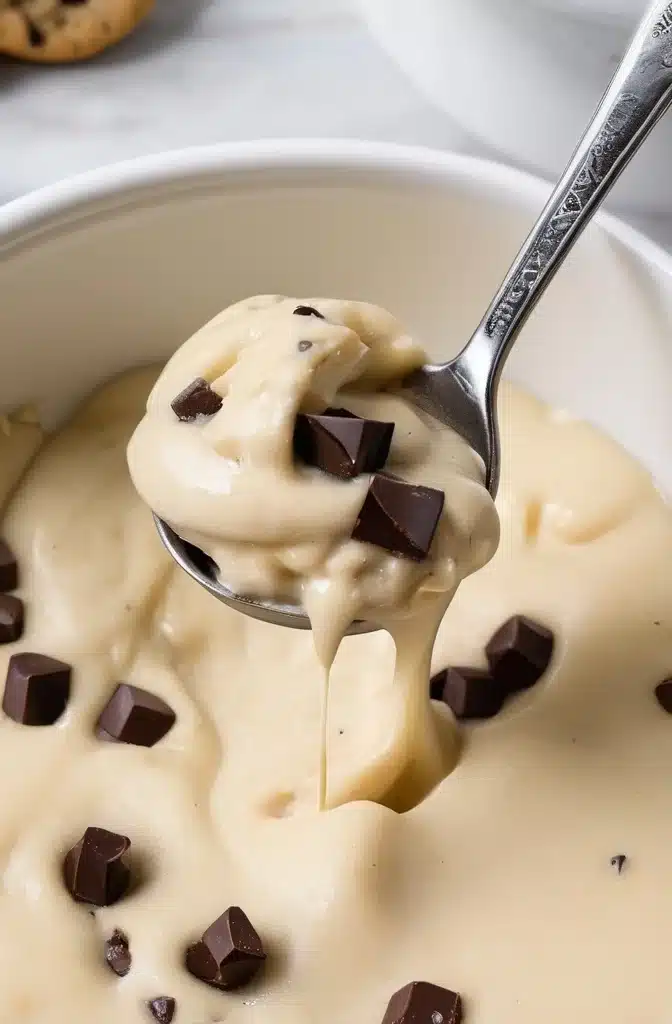Have you ever found yourself standing in front of the fridge at midnight, spoon in hand, desperately trying to resist the siren call of raw cookie dough? I’ve certainly been there. That forbidden pleasure—the cool, sweet dough with chocolate chips melting on your tongue—is something many of us crave, despite knowing the risks of raw eggs and flour. But what if I told you there’s a way to indulge safely, with added protein to boot? Greek yogurt cookie dough is my secret weapon, and I’m bout to share it with ya.
Greek yogurt cookie dough isn’t just another internet food trend. It’s a legitimately delicious, protein-packed treat that satisfies sweet cravings without the food safety concerns of traditional raw dough. The tanginess of Greek yogurt creates a complexity that actually enhances the flavor profile beyond regular cookie dough, giving it a subtle depth that’ll keep you coming back for more.
Ingredients & Substitutions
Base Ingredients
- 1 cup Greek yogurt (full-fat preferred)
- 3 tablespoons almond flour or oat flour
- 2 tablespoons maple syrup or honey
- 1 tablespoon melted coconut oil or butter
- 1 teaspoon vanilla extract
- ¼ teaspoon salt
- ⅓ cup chocolate chips (mini chips work best)
- Optional: 1 tablespoon protein powder
The type of Greek yogurt you choose makes a massive difference here. Full-fat versions create a richer, more authentic cookie dough texture, while nonfat options work if your counting calories but will yield a slightly tangier result. For those avoiding dairy altogether, coconut yogurt can be substituted, tho you’ll loose some of the protein benefits and may need to adjust the sweetener levels.
Almond flour creates the most cookie-like texture, but oat flour works beautifully for those with nut allergies. Both options are heat-treated to eliminate any bacterial concerns associated with raw flour. Regular all-purpose flour should NEVER be used without heat treatment (bake spread on a baking sheet at 350°F for 5 minutes, then cool completely).
Sweetener Options
Maple syrup gives a caramel-like undertone that complements the yogurt’s tanginess perfectly, but honey works brilliantly too. For keto adaptations, liquid monkfruit or allulose allows you to maintain the right consistency without the carbs. Brown sugar can be used in a pinch, but you might need to add a touch more liquid to achieve the right consistency.
Chocolate selection matters tremendously in this recipe. Standard semi-sweet chips provide that classic cookie dough experience, while dark chocolate adds a sophisticated edge. For those monitoring sugar intake, stevia-sweetened chocolate chips or even cacao nibs can be substituted. White chocolate chunks with dried cranberries create a stunning flavor variation that’s worth trying at least once.
Step-by-Step Instructions
Preparing Your Base
- Start by heat-treating your flour if not using pre-packaged alternatives. Spread almond or oat flour on a baking sheet and bake at 350°F for about 5 minutes, then allow to cool completely before using. This step eliminates any harmful bacteria that might be present in raw flour.
- In a medium mixing bowl, combine the Greek yogurt and melted coconut oil, stirring until smooth and well-integrated. The oil might seem to seize up if your yogurt is cold straight from the fridge—this is totally normal and will incorporate as you continue mixing.
- Add your sweetener of choice and vanilla extract, then mix until completely incorporated. Don’t rush this step; proper emulsification here ensures a smooth, cohesive dough rather than something that tastes like sweetened yogurt with mix-ins.
Creating the Perfect Texture

The most common pitfall when making yogurt cookie dough is incorrect texture. Too wet, and it feels nothing like cookie dough; too dry, and it becomes crumbly and disappointing. The key is gradual addition of your dry ingredients.
Add the heat-treated flour and salt to your yogurt mixture about a tablespoon at a time, folding gently until incorporated before adding more. You’re looking for that specific cookie dough consistency—slightly firm but still soft and scoopable. If your mixture becomes too dry, a teaspoon of milk can rescue it. Conversely, if it’s too wet, a sprinkle of additional flour will help.
Protein powder can be incorporated at this stage if desired, but be aware that different brands absorb moisture differently. I recommend starting with half the amount suggested and adjusting as needed.
Adding Mix-ins
Fold in your chocolate chips or other mix-ins just until distributed. Overworking the dough at this stage can cause the yogurt to release moisture, creating a less pleasant texture. For those who love that iconic cookie dough experience, mini chocolate chips distribute more evenly throughout the dough, giving you that perfect chocolate-in-every-bite sensation.
For next-level flavor complexity, try toasting your mix-ins beforehand. Briefly toasting nuts or coconut flakes in a dry skillet releases their natural oils, amplifying their flavor presence in the final product.
Cooking Techniques & Science
While this is technically a “no-cook” recipe, understanding the science behind it helps achieve perfection every time. Greek yogurt works so brilliantly in this application because of its unique protein structure and acidity. The protein content (roughly 15-20g per cup compared to regular yogurt’s 9g) provides a density and body that mimics the egg proteins in traditional cookie dough.
The acidity of Greek yogurt serves two important purposes. First, it creates a preservation effect that extends shelf life beyond what you’d expect from a refrigerated dairy product. Second, it interacts with the sweeteners to create a balanced flavor profile that doesn’t read as “yogurty” but rather as authentic cookie dough.
Temperature control is secretly crucial here. Working with ingredients at room temperature allows for better integration and texture development. If you’re in a hurry, you can microwave cold yogurt for 10-15 seconds—just enough to take the chill off without actually warming it.
The inclusion of a small amount of fat (via coconut oil or butter) is not merely for flavor—it’s structural. The fat molecules coat the protein strands in the yogurt, preventing them from binding too tightly together, which would create a gummy rather than creamy texture. This is similar to how fat functions in traditional cookie dough, separating the flour proteins to prevent excessive gluten development.
Variations to Explore
The beauty of this base recipe lies in its adaptability. Here are some spectacular variations to explore:
Chocolate Peanut Butter Cup
Add 2 tablespoons of natural peanut butter to the base and use chopped peanut butter cups instead of chocolate chips. The slight saltiness of natural peanut butter creates a sophisticated sweet-salty balance that processed versions can’t match.
Snickerdoodle
Replace vanilla extract with ¼ teaspoon almond extract, add ½ teaspoon cinnamon to the dough, and roll finished dough balls in a mixture of cinnamon and granulated sugar. The warming spice notes transform this into a perfect fall or winter treat.
Birthday Cake
Add ¼ teaspoon almond extract alongside the vanilla, fold in 2 tablespoons of rainbow sprinkles, and use white chocolate chips instead of semi-sweet. The slight tang of the yogurt beautifully counterbalances the sweetness of this variation.
Lemon Blueberry
Add 1 teaspoon lemon zest and ¼ cup dried blueberries instead of chocolate chips. Fresh blueberries can be used but will significantly shorten the shelf life due to their high moisture content.
Serving & Pairing Suggestions

Greek yogurt cookie dough can be enjoyed straight from the bowl like traditional cookie dough, but its versatility extends beyond that simple pleasure. Try forming it into truffle-sized balls and freezing for 30 minutes for a more substantial dessert experience. These firmed-up balls can be dipped halfway in melted dark chocolate and sprinkled with flaky sea salt for an elegant presentation that belies their healthy origin.
For brunch gatherings, serve small scoops in espresso cups with fresh berries for a deconstructed dessert parfait that’s both sophisticated and playful. The contrast between the creamy dough and juicy berries creates a textural experience that’s genuinely memorable.
As a dinner party dessert, consider serving small scoops atop warm grilled fruit—pineapple, peaches, or pears work beautifully. The temperature contrast and caramelization from grilling creates a dessert worthy of high-end restaurants, yet it’s astonishingly simple to prepare.
Beverage pairings can elevate this simple treat to extraordinary heights. A medium-roast coffee with nutty undertones complements the vanilla notes in the base recipe, while a dessert wine like Sauternes creates magical harmony with the chocolate-studded version. For family-friendly options, almond milk infused with cinnamon makes a surprisingly sophisticated accompaniment.
Storage & Make-Ahead Tips
One of this recipe’s greatest advantages is its make-ahead potential. The finished dough can be stored in an airtight container in the refrigerator for up to 5 days, making it perfect for gradual enjoyment throughout the week. The flavor actually improves after 24 hours as the ingredients have time to meld—similar to how traditional cookie dough develops complexity as it rests.
For longer storage, portion the dough into tablespoon-sized scoops and freeze on a parchment-lined baking sheet. Once frozen solid, transfer to a freezer bag where they’ll keep for up to 3 months. This method allows you to enjoy a single portion whenever cravings strike, without committing to eating the entire batch.
Interestingly, this dough can actually be baked into cookies, although the result is more akin to yogurt shortbread than traditional chocolate chip cookies. If attempting this, add an additional 3 tablespoons of flour and ¼ teaspoon of baking soda to the base recipe, then bake at 350°F for approximately 10 minutes.
Conclusion
Greek yogurt cookie dough represents the perfect intersection of nutritional awareness and culinary indulgence—a space where legitimate deliciousness meets better-for-you ingredients. The protein boost from Greek yogurt transforms what would otherwise be a guilty pleasure into a treat that can reasonably fit within a balanced approach to eating.
The versatility of this base recipe opens up endless possibilities for personalization, meaning it can evolve with your mood or the seasons. From childhood-reminiscent chocolate chip to sophisticated flavor combinations worthy of gourmet dessert menus, Greek yogurt cookie dough adapts to whatever culinary story you wish to tell.
Perhaps most importantly, this recipe resolves the eternal dilemma of cookie dough lovers everywhere—how to safely enjoy that forbidden pleasure without concern. By eliminating raw eggs and properly treating the flour, we’ve created a worry-free version of one of life’s simple pleasures. And isn’t that what thoughtful cooking is ultimately about? Finding ways to honor our cravings while still caring for our wellbeing.
FAQs
Is this recipe safe to eat without baking?
Absolutely! Unlike traditional cookie dough, this recipe contains no raw eggs. Just make sure to heat-treat your flour (bake at 350°F for 5 minutes, then cool) if not using pre-packaged alternatives like almond or oat flour. This eliminates any potential bacteria present in raw flour.
Can I use non-dairy yogurt alternatives?
Yes, coconut yogurt works particularly well as a substitute. However, plant-based yogurts typically have less protein than Greek yogurt, so you might want to add a tablespoon of protein powder to achieve a similar nutritional profile. The texture may also be slightly different, possibly requiring minor adjustments to the flour quantity.
How long can I store this in the refrigerator?
When stored in an airtight container, Greek yogurt cookie dough remains fresh for up to 5 days in the refrigerator. The acidity in the yogurt actually helps preserve it longer than you might expect. For even longer storage, freeze portioned dough balls for up to 3 months.
Can this dough be baked into actual cookies?
While developed primarily as an edible dough, this recipe can be adapted for baking. Add an additional 3 tablespoons of flour and ¼ teaspoon of baking soda to the base recipe, then bake at 350°F for about 10 minutes. The result is more like a yogurt shortbread than a traditional chocolate chip cookie—different but delicious!
Why is my dough too wet/sticky?
The moisture content of different Greek yogurt brands varies significantly. If your dough seems too wet, gradually add more flour a teaspoon at a time until you reach the desired consistency. Conversely, if it’s too dry, a splash of milk will help achieve that perfect cookie dough texture.
